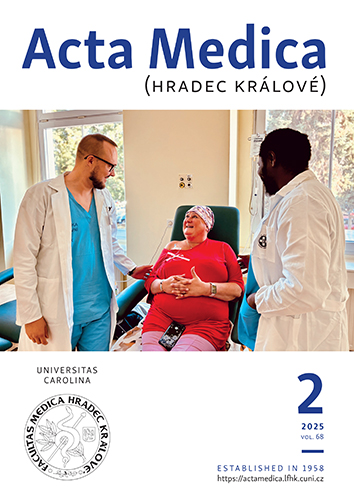ACTA MEDICA, Vol 57 No 4 (2014), 142–150
Nanotechnology – New Trends in the Treatment of Brain Tumours
Petr Krůpa, Svatopluk Řehák, Daniel Diaz-Garcia, Stanislav Filip
DOI: https://doi.org/10.14712/18059694.2015.79
published online: 05. 05. 2015
abstract
High grade gliomas are some of the deadliest human tumours. Conventional treatments such as surgery, radiotherapy and chemotherapy have only a limited effect. Nowadays, resection is the common treatment of choice and although new approaches, such as perioperative magnetic resonance imaging or fluorescent microscopy have been developed, the survival rate of diagnosed patients is still very low. The inefficacy of conventional methods has led to the development of new strategies and the significant progress of nanotechnology in recent years. These platforms can be used either as novel imaging tools or to improve anticancer drug delivery into tumours while minimizing its distribution and toxicity in healthy tissues. Amongst the new nanotechnology platforms used for delivery into the brain tissue are: polymeric nanoparticles, liposomes, dendrimers, nanoshells, carbon nanotubes, superparamagnetic nanoparticles and nucleic acid based nanoparticles (DNA, RNA interference [RNAi] and antisense oligonucleotides [ASO]). These nanoparticles have been applied in the delivery of small molecular weight drugs as well as macromolecules – proteins, peptides and genes. The unique properties of these nanoparticles, such as surface charge, particle size, composition and ability to modify their surface with tissue recognition ligands and antibodies, improve their biodistribution and pharmacokinetics. All of the above mentioned characteristics make of nanoplatforms a very suitable tool for its use in targeted, personalized medicine, where they could possibly carry large doses of therapeutic agents specifically into malignant cells while avoiding healthy cells. This review poses new possibilities in the large field of nanotechnology with special interest in the treatment of high grade brain tumours.
keywords: Biotechnology; Nanotechnology; Target therapy; Brain tumour

Nanotechnology – New Trends in the Treatment of Brain Tumours is licensed under a Creative Commons Attribution 4.0 International License.
210 x 297 mm
periodicity: 4 x per year
print price: 150 czk
ISSN: 1211-4286
E-ISSN: 1805-9694
